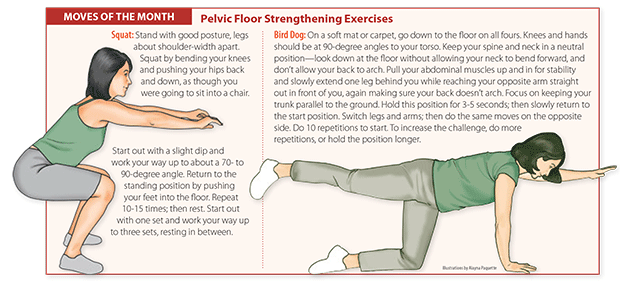Strengthen Your Pelvic Floor Muscles
If you have pain in your lower abdominal area or are challenged by incontinence issues that prevent you from living a complete life, you may be suffering from a pelvic floor disorder (PFD).
PFDs affect 25 percent of all women, according to the National Institutes of Health. That number rises to 37 percent for women over 60 and to 50 percent for women 80 and older.
The pelvic floor is like a bridge that connects the front of the pelvic cavity to the back. “Pelvic floor muscles help to support your pelvic organs, including the uterus, bladder, and rectum,” explains Anna Ribaudo, a board certified orthopedic specialist at the Weill Cornell-affiliated Hospital for Special Surgery’s Integrative Care Center.
A PFD results when the muscles and connective tissue within the pelvic cavity weaken or are injured. Factors affecting PFDs include age, past pregnancies, surgery (such as a hysterectomy), weight, and injury. It also can be exacerbated by a long-term infection or endometriosis. You might experience urine leakage, pain during sex, or pain when lifting something heavy.
The benefits of a strong pelvic floor include lowering your risk of vaginal or rectal prolapse (collapsing), better bladder and bowel control, and overall ease with maintaining good posture and stability, since your pelvic floor—along with your core muscles—make up the base of your body’s musculoskeletal system.
Improving Pelvic Floor Strength
If you are diagnosed with a PFD, your treatment plan advised by your doctor will likely include some strengthening exercises. The “Kegel” has been the go-to exercise for pelvic floor strengthening. A Kegel turns on the muscles that stop the flow of urine. “If you can stop your flow midstream, you have successfully isolated the right muscles,” Ribaudo says.
To make this exercise even more effective, she says, work your Kegel while performing an abset—this involves pulling your belly button in toward your spine to engage your core muscles. “Once you have mastered doing both of these contractions, practice doing them at the same time.”
The best way to strengthen these muscles is to practice during the day. “Think about engaging your abset along with your Kegel while walking, waiting at a red light, climbing stairs, etc. Work up to holding these contractions for one minute to build endurance.”
A squat is a great exercise for your legs. But add a Kegel and an abset—“now you’re making it three times as effective by including your core and pelvic floor,” Ribaudo says.
The bird-dog exercise is a core exercise that emphasizes low back strength and balance. “It can double as a pelvic floor exercise if you maintain a Kegel while doing it,” says Ribaudo. “This should even increase your overall balance while performing the exercise.”

The post Strengthen Your Pelvic Floor Muscles appeared first on University Health News.
Read Original Article: Strengthen Your Pelvic Floor Muscles »
Powered by WPeMatico

